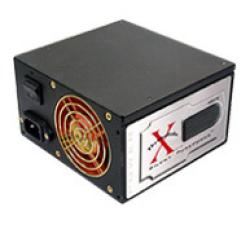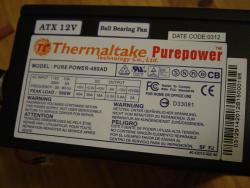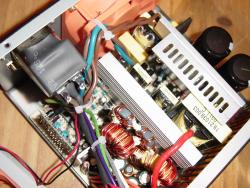2003 Power Supply Roundup Part II: Better Faster Cheaper
by Kristopher Kubicki on July 31, 2003 1:58 PM EST- Posted in
- Cases/Cooling/PSUs
ThermalTake sent us their PurePower 420W APFC for our last power supply roundup<link>, but it could not keep up with Enermax and Antec. The 480W PurePower supply is a little more powerful than the previous one we looked at, so we have slightly higher expectations.
Like Antec’s TrueControl, the ThermalTake PurePower looks like a very different power supply than the original 420W power supply from several months ago. Also like the TrueControl, this power supply comes with a forward fan control. There is no ability to control the fan speed of the fans connected to the unit, but the control does allow manipulation of the onboard fans. Interestingly enough, the PurePower 480W comes with 2 different control panels, (one gold, and one silver). If you happen to prefer one color over another, ThermalTake allows you to choose one instead of another.
The ThermalTake PurePower 480W includes on SATA connection. Most serial ATA hard drives come with SATA adaptors anyway, but it is good to see some manufacturers anticipating the mainstream adoption of the technology. We continue to expect more power supplies to come with these connectors.
Wattages
|
|
3.3V |
5V |
12V |
-12 |
-5 |
+5vsb |
combined theoretical |
actual combined |
advertised total |
|
ThermalTake PurePower 480W |
99.00 |
200.00 |
216.00 |
9.60 |
1.50 |
10.00 |
299.00 |
240.00 |
480.00 |
The PurePower 480W wattages are well rounded for either an Intel or AMD system. One thing to note is that the combined +3.3V/+5.0V wattages are very high at 240W. There is plenty of muscle in this power supply for an AMD or Intel system.
The ThermalTake PurePower 480W is a moderately priced power supply, about $74. However, considering the 420W PurePower cost $110 last year, we can tell that ThermalTake is making progress in producing a better product for lesser cost.













70 Comments
View All Comments
Anonymous User - Thursday, August 7, 2003 - link
With each review unit, show a picture of the insides. Some of us can tell the design differences by looking at a picture.Claimed efficiency is a selling feature. An efficient unit doesn't need as much cooling air, and is easier on the electric bill.
See if you can rent a load tester. Do a current ramp on the rails, to see what kind of dynamic response the units have. On +12V, this would happen when going from stop-grant, to 100% computing load. Power supplies overshoot when this happens.
Your memory test is meaningless. A motherboard voltage regulator filters the rails, so this is unlikely to be a source of trouble with memory. Radiated emissions (E or M field) can influence circuitry, but you should use a spectrum analyser plus pickup coil to get some idea.
Another emission test, is EMI coming out of the power supply via the power cord. For example, my Truepower interferes with Channel 4 on my TV set. This means the common mode EMI filter at the input to the PS is insufficient. Consult with an EMI expert on how to measure this.
Overvoltage and overcurrent protection were not mentioned. Some units don't do it on all high output rails. Some don't do it at all. One unit had a circuit breaker on the back, which is a significant difference worth mentioning. The tolerance on some protection circuits is so sloppy, that the unit will burn before it trips.
No review I've read so far has mentioned this clause in the ATX spec which is available from formfactors.org "The maximum short-circuit energy in any output shall not exceed 240 VA, per IEC 60950 requirements."
For the high power models which violate this fire containment requirement, will my house insurance cover me if my PC lights the house on fire ?
This requirement could be met by using separate outputs for +12 to motherboard and +12 to drives.
Fire danger is a good reason not to use acrylic windows on a PC case.
Anonymous User - Wednesday, August 6, 2003 - link
"Several months ago, we published our first power supply roundup."Do you mean this one from 42 months ago? :)
http://www.anandtech.com/showdoc.html?i=1128&p...
Anonymous User - Wednesday, August 6, 2003 - link
pretty sweet review,the noise results were v interesting - does this mean that any computer without ECC memory is inherantly unstable?
Anonymous User - Wednesday, August 6, 2003 - link
Hm... The memory test makes me wonder. Two things basically:1) How do you know the errors really are caused by the PSU? The figures suggest that it is, but have all other possible sources been ruled out? The numbers are low, and could be random variations for all I know.
2) If memory content changes during 6 hours without read or write (and only the normal refresh), what does that mean for reliability on computers with up-times of months or even years? On the other hand, this could be the reason servers have ECC memory...
Anonymous User - Wednesday, August 6, 2003 - link
Without wishing to be defamatory, Q-Tec units suck. In life you get what you pay for. These units have no safety circuits at all. They are of 'unlimited' design and the only control mechanism is when a component blows up. In so doing it may well take your mobo etc with it. Their top of the range unit provides less power on the 3.3v and 5v rails that most quality 300 watt units.Anonymous User - Wednesday, August 6, 2003 - link
You show the 'actual combined' on the huge EG651 Enermax at 200 watts. This is less than some 300 watt units. Why did you not highlight this? And why do Enermax put a 651 number on a 550 watt unit? Everyone else uses the number as the rated power figure.Goi - Wednesday, August 6, 2003 - link
I'd like to see reviews of Heroichi(HEC), aka Compucase, as well as Enlight, Topower and if possible Verudium PSUs. Also, the "ripple" measurements were only taken over a 30-60s duration, and only at full load. Other than the fact that what was measured isn't called "ripple" but actually the voltage fluctuation on the individual voltage rail, 30-60s sounds like a very short time window, and this should be measured both at idle and load conditions, since we all know that voltages tend to fluctuate when going from idle to load conditions and/or vice versa.Anonymous User - Wednesday, August 6, 2003 - link
How about Topower PSU's? I have seen a review elsewhere that says their 400W has similar performance to Enermax's (at a much lower price), but it was nowhere near as in-depth as your article.Anonymous User - Tuesday, August 5, 2003 - link
Antec 330 true power's performance on 12v is not enough for a P4 or high end video card? Funny, I have both and haven't had a problem........Anonymous User - Tuesday, August 5, 2003 - link
I personally thought the Antec True Power 330 was shining a little bit in this review. With 31.0 - 34.5 dBa noise, 26.5 - 33.8 C temp, on the lower end of memory errors, and a little tighter voltages than the average, it seems like it gives you the best combination of all categories. The only thing we're missing is some of the wattage testing. What do you guys think? And what about some of the other True Power product line - perhaps the 430 since 330 is at the lower end of PSU size that I would like to get for the power usage of any new computer (the True Control 550 is in a different product line than the True Power).